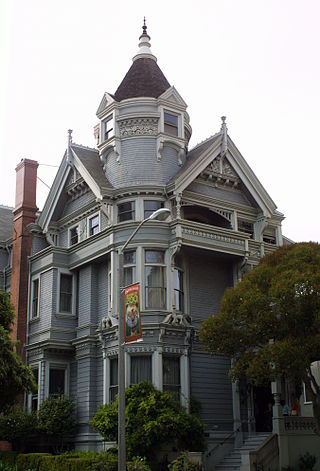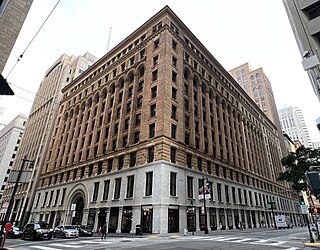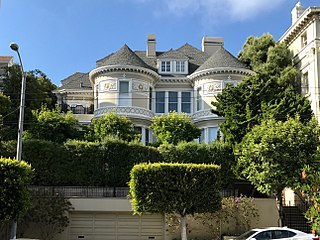
Bernard Ralph Maybeck was an American architect in the Arts and Crafts Movement of the early 20th century. He was an instructor at University of California, Berkeley. Most of his major buildings were in the San Francisco Bay Area.

The Haas–Lilienthal House is a historic building located at 2007 Franklin Street in San Francisco, California, United States, within the Pacific Heights neighborhood. Built in 1886 for William and Bertha Haas, it survived the 1906 San Francisco earthquake and subsequent fire. The Victorian era house is a San Francisco Designated Landmark and is listed on the U.S. National Register of Historic Places. It was converted into museum with period furniture and artifacts, which as of 2016 received over 6,500 visitors annually.

The Feusier Octagon House is an historic octagonal house built in c. 1857, and located in the Russian Hill neighborhood of San Francisco, California.

The Mills Building and Tower is a two-building complex following the Chicago school with Romanesque design elements in the Financial District of San Francisco, California. The structures were declared San Francisco Designated Landmark #76, and were listed on the National Register of Historic Places in 1974.
Edward Coleman (1830–1913) was an American mine manager, president, and superintendent during the California gold rush in Nevada County. He also served as President of the Board of School Trustees in Grass Valley; and Vice President of the Nevada County Narrow Gauge Railroad. His brother, John C. Coleman, was the railroad's first president; John was also president of the North Star Mine.
Frederick Herman Meyer was an American architect. He was active in the San Francisco Bay Area, and is known for designing the YMCA Hotel in San Francisco. From c.1898 until 1901, Samuel Newsom worked with Meyer, to form the firm Newsom and Meyer in Oakland. Starting in 1902 and until 1908, Meyer entered into a partnership with architect Smith O'Brien to form the form Meyer and O'Brien.

Louis Sloss Sr. was an American businessman who co-founded the Alaska Commercial Company.

The Frank G. Edwards House is a historic residential building built in 1883, and located at 1366 Guerrero Street in the Noe Valley section of San Francisco, California.
Samuel Newsom was a Canadian-born American architect. Together with his brother Joseph Cather Newsom founded the architecture firm Newsom and Newsom, practicing in Northern and Southern California. Their most celebrated house is the Carson Mansion in Eureka, California.

Wormser-Coleman House, also known as the Isaac Wormser House and John C. Coleman House, is a historical building built in 1876, located at 1834 California Street in San Francisco, California. It has been listed as a San Francisco Designated Landmark since 1973. As of 2022, the building is a private residence.

Archbishop's Mansion is a historic house built in 1904 and located at 1000 Fulton Street in the Alamo Square neighborhood in San Francisco, California. The mansion was built for Patrick William Riordan, the second Roman Catholic Archbishop of San Francisco.

The Chambers Mansion is a historic house that was built in 1887, and is located at 2220 Sacramento Street in the Pacific Heights neighborhood of San Francisco, California. In 2010, CBS News declared the Chambers Mansion one of the "scariest haunted houses" in the United States, based on stories of its dark history.

The Colombo Building, also known as the Drexler Building or Drexler-Colombo Building, is a historic commercial building built in 1913, and is located at 1–21 Columbus Avenue in the Jackson Square Historic District in San Francisco, California.

The Fallon Building, also known as the Carmel Fallon Building, is a historic mixed-use building built in 1894 and located in the Castro District of San Francisco, California. It is the home of the San Francisco LGBT Center since 2002.

The Liberty Hill Historic District is a historic district located in the Dolores Heights neighborhood of San Francisco, California, U.S.. It is a residential neighborhood bound by 20th, Mission, Dolores, and 22nd Streets. It is listed as a San Francisco Designated Landmark since October 25, 1985.

Charles Dietle House, or Dietle House, is a historic building, built in 1878 in the Hayes Valley neighborhood of San Francisco, California. It has been listed as a San Francisco designated landmark since 1972. It is a private house and not open to the public.

Casebolt House is a historic residence in the Cow Hollow district of San Francisco, California, U.S.. It is the oldest house in the neighborhood, built in c. 1865. It is a San Francisco designated landmark since 1973.

Clay Theatre is a historic 1913 single screen theater building in the Pacific Heights neighborhood of San Francisco, California, United States. It was formerly known as TheRegent, TheAvalon, The Clay International, and Landmark's Clay Theatre. It has been listed as a San Francisco Designated Landmark since May 6, 2022.

The Havens Mansion and Carriage House is a historic residential building in the Mission District of San Francisco, California, United States. It was listed as a San Francisco Designated Landmark since 1981. It is a private residence and is not open to the public.

The Madame C.J. Walker Home for Girls and Women, or simply Walker Home, is a historic Italianate building in the Lower Pacific Heights neighborhood of San Francisco, California, U.S.. From 1921 to 1972, the building housed a charitable, community and social services organization for single African American woman new to San Francisco, who were not eligible to use the YWCA.



















